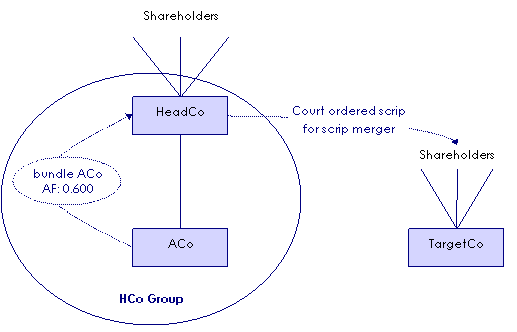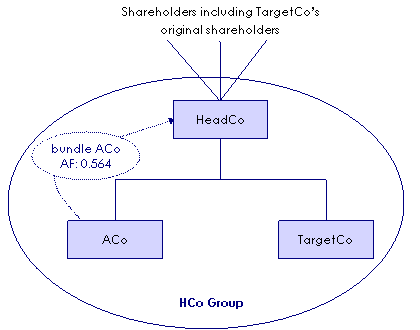Consolidation Reference Manual
You can still refer to the Consolidation reference manual for consolidation information that has not been impacted by changes in the legislation.
C3 Losses
C3-4 Worked example - loss utilisation
Adjusting the available fraction
C3-4-342 Adjusting available fraction - post-consolidation injection of capital where head company issues shares in scrip for scrip merger
Description
This example shows the application of adjusting event 4 to an injection of capital into a consolidated group when the head company issues new shares in itself to acquire membership interests in another entity (scrip for scrip merger or takeover). Item 4 in the table in subsection 707-320(2) of the ITAA 1997 may operate to reduce the available fraction for an existing bundle of losses of the consolidated group. The adjustment required, if any, will depend on the impact of the injection of capital on the market value of the group.
This example shows the head company using the short cut option to determine the reduction.
Commentary
The available fraction for a bundle of losses is reduced if the market value of the company [F1] to which the losses were most recently transferred is increased as a result of either of these events:
- •
- an injection of capital [F2] into the group or an associate of the group, or
- •
- a non-arm's length transaction that involves the group or an associate [F3] of the group. → subsection 707-325(4), ITAA 1997
When applying item 4 in the table in subsection 707-320(2) (adjusting event 4) to an existing consolidated group, each available fraction is reduced just after the event by multiplying it by the following factor:
Market value of the company just before the event/Market value of the company just before the event + Amount of the increase
The reference to an increase in the market value of the company will mean an increase in the market value of the entire consolidated group where the company still meets the definition of a head company in section 703-15. This is as a result of the operation of the single entity rule. [F4] As this worked example focuses on adjusting event 4 applying to a head company, the term 'market value of the group' is used hereafter for ease of understanding.
Timing of the event - merger effected by way of a court ordered scheme of arrangement
A reduction to the available fractions of existing loss bundles may be necessary in a scrip for scrip merger or takeover, where the head company of a consolidated group issues additional shares in itself in return for the acquisition of 100% of the membership interests in an entity. This is considered to be an event (an injection of capital) for the purposes of adjusting event 4 in subsection 707-320(2). [F5]
A merger of entities can occur by way of a court ordered scheme of arrangement. For such an arrangement, the event described in subsection 707-325(4) is taken to have occurred on the merger implementation date. This is when the shares in the target company are transferred to the bidder company. It is at this time the bidder entity will beneficially own the assets of the target.
Four-step process to calculate reduced available fractions
There are four steps to determine the reduced available fraction for each bundle of losses in a situation where adjusting event 4 applies:
- 1
- Determine the market value of the consolidated group just before the event.
- 2
- Determine the increase in the market value of the consolidated group attributable to the injection of capital or non-arm's length transaction.
- 3
- Divide the step 1 amount by the sum of the step 1 and step 2 amounts.
- 4
- Multiply the available fraction for the bundle of losses by the step 3 factor. Repeat for each bundle of losses.
Impact on market value
A reduction to available fractions is required if there is an increase in the market value of the consolidated group as a result of the event. The market value of the group may increase as a consequence of the group's ownership and control of the acquired entity.
A method of establishing the amount of the increase in respect of an event is to obtain two valuations. The first would be undertaken as at the time just after the event occurs. The second valuation would be undertaken as at that time on the assumption the event did not take place. This second valuation establishes what the market value would have been had the event not occurred. The difference between these two valuations establishes the amount of the increase.
In arriving at an assessment of the impact of the event on the market value, the Tax Office expects taxpayers to clearly demonstrate, where required, how the valuation has been calculated. Assumptions made in arriving at a valuation should be documented and supportable.
Short cut option
A short cut option is available where all the shares in the head company are ordinary shares and listed on the Australian Stock Exchange (ASX).
If the short cut option is chosen, both elements of the short cut must be adopted.
(1) Market value just before the event
The Tax Office will accept, as the market value of the consolidated group just before the event (the step 1 amount), the amount obtained by multiplying the ASX share price at that time by the number of shares.
(2) Amount of the increase - scrip for scrip mergers or takeovers
Where the event is a scrip for scrip merger or takeover that is effected by way of a court ordered scheme of arrangement, the Tax Office will accept the listed ASX share price at the end of the merger implementation date multiplied by the amount of new shares issued to effect the merger as the amount of the increase.
Example
Facts
The HCo Group, a consolidatable group consisting of HeadCo and its wholly-owned subsidiary ACo, consolidates on 1 July 2003.
A tax loss is transferred from ACo to HeadCo at the time the consolidated group is formed. The available fraction calculated for the bundle containing the loss (bundle ACo) is 0.600.
On 1 November 2003, HeadCo is granted, by way of a court ordered scheme of arrangement, the right to acquire all of the shares in TargetCo. Shareholders of TargetCo are entitled to receive $2.00 and three HeadCo shares for each TargetCo share. There are 300,000 issued shares in TargetCo.
The merger implementation date occurs on 1 December 2003, when HeadCo allocates the cash and new shares to TargetCo's shareholders and TargetCo's shares are transferred to HeadCo.
The issue of new shares by HeadCo in return for acquiring TargetCo is considered an event [F6] for the purposes of adjusting event 4 in subsection 707-320(2) in relation to HeadCo. This event is taken to have occurred on the merger implementation date (i.e. 1 December 2003).
The event has a positive impact on the value of HeadCo as a consequence of the group's ownership and control of TargetCo. As a result, the available fraction for bundle ACo must be reduced under adjusting event 4. These facts are represented in Figures 1 and 2 and below.
Figure 1: HCo Group and the scrip for scrip merger (1 November 2003)

Figure 2: HCo group after the scrip for scrip merger (1 December 2003)

Calculation
HeadCo chooses to use the available short cuts to determine the adjustment required. Data extracted from the share register of HeadCo is shown in table 1.
| Date | Issued shares | Share Price ($) |
|---|---|---|
| 30.11.03 | 15,000,000 | 0.32 |
| 01.12.03 | 15,900,000 | 0.36 |
Applying the short cut option:
| Step | Explanation | Amount |
|---|---|---|
| 1 | Market value just before event | $4.8 million (15,000,000 x $0.32) |
| 2 | Amount of the increase | $324,000 (900,000 x $0.36) |
| 3 | Factor | $4.8 million / ($4.8 million + $324,000) = 0.94 |
| 4 | Adjust available fraction | 0.600 × 0.94 = 0.564 |
The available fraction for bundle ACo is adjusted on 1 December 2003 to 0.564.
As the adjustment has taken place part-way through the 2004 income year, utilisation of the loss in bundle ACo must be apportioned. → section 707-335, ITAA 1997
Apportionment recognises that an available fraction has only applied for a part of the income year. → 'Apportioning the use of transferred losses', C3-4-610
References
Income Tax Assessment Act 1997 :
- •
- item 4 in the table in subsection 707-320(2)
- •
- subsection 707-325(4)
- •
- section 707-335
Income Tax Assessment Act 1936 :
Taxation Ruling TR 2004/9
ATO Interpretative Decision 2004/961
Revision history
Section C3-4-343 first published 6 April 2006.
Proposed changes to consolidation
Proposed changes to consolidation announced by the Government are not incorporated into the Consolidation reference manual until they become law. In the interim, information about such changes can be viewed at:
- •
- http://assistant treasurer.gov.au (Assistant Treasurer's press releases)
- •
- www.treasury.gov.au (Treasury papers on refinements to the consolidation regime).
Current at 6 April 2006
This will generally be the head company of a consolidated group or MEC group. In a situation where the consolidated group or MEC group has ceased to exist, this will be the former head company of that group.
Taxation Ruling TR 2004/9 provides the Tax Office view on the meaning of the expression 'injection of capital,'
'Associate' is defined in section 318, ITAA 1936.
For a MEC group, ATO Interpretative Decision 2004/961 states that a reference to the 'market value of the company' in item 4 in the table in subsection 707-320(2) is a reference to the market value of the entire MEC group.
Paragraphs 13 and 59 of Taxation Ruling TR 2004/9.
An injection of capital under paragraph 707-325(4)(a) - refer paragraphs 13 and 59 of TR 2004/9.
